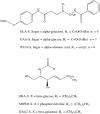Pilot study of newborn screening for six lysosomal storage diseases using Tandem Mass Spectrometry
- PMID: 27238910
- PMCID: PMC5318163
- DOI: 10.1016/j.ymgme.2016.05.015
Pilot study of newborn screening for six lysosomal storage diseases using Tandem Mass Spectrometry
Abstract
Background: There is current expansion of newborn screening (NBS) programs to include lysosomal storage disorders because of the availability of treatments that produce an optimal clinical outcome when started early in life.
Objective: To evaluate the performance of a multiplex-tandem mass spectrometry (MS/MS) enzymatic activity assay of 6 lysosomal enzymes in a NBS laboratory for the identification of newborns at risk for developing Pompe, Mucopolysaccharidosis-I (MPS-I), Fabry, Gaucher, Niemann Pick-A/B, and Krabbe diseases.
Methods and results: Enzyme activities (acid α-glucosidase (GAA), galactocerebrosidase (GALC), glucocerebrosidase (GBA), α-galactosidase A (GLA), α-iduronidase (IDUA) and sphingomyeline phosphodiesterase-1 (SMPD-1)) were measured on ~43,000 de-identified dried blood spot (DBS) punches, and screen positive samples were submitted for DNA sequencing to obtain genotype confirmation of disease risk. The 6-plex assay was efficiently performed in the Washington state NBS laboratory by a single laboratory technician at the bench using a single MS/MS instrument. The number of screen positive samples per 100,000 newborns were as follows: GAA (4.5), IDUA (13.6), GLA (18.2), SMPD1 (11.4), GBA (6.8), and GALC (25.0).
Discussion: A 6-plex MS/MS assay for 6 lysosomal enzymes can be successfully performed in a NBS laboratory. The analytical ranges (enzyme-dependent assay response for the quality control HIGH sample divided by that for all enzyme-independent processes) for the 6-enzymes with the MS/MS is 5- to 15-fold higher than comparable fluorimetric assays using 4-methylumbelliferyl substrates. The rate of screen positive detection is consistently lower for the MS/MS assay compared to the fluorimetric assay using a digital microfluidics platform.
Keywords: Dried blood spot; Fabry disease; Gaucher disease; Hurler disease; Krabbe disease; Lysosomal storage disorders; Newborn screening; Niemann-Pick-A/B disease; Pompe disease; Tandem mass spectrometry.
Copyright © 2016 The Authors. Published by Elsevier Inc. All rights reserved.
Figures


References
-
- Chamoles NA, Blanco M, Gaggioli D. Diagnosis of alpha-L-iduronidase deficiency in dried blood spots on filter paper: the possibility of newborn diagnosis. Clin Chem. 2001;47:780. - PubMed
-
- Chamoles NA, Blanco M, Gaggioli D, Casentini C. Tay-Sachs and Sandhoff diseases: enzymatic diagnosis in dried blood spots on filter paper: retrospective diagnoses in newborn-screening cards. Clin Chim Acta. 2002;318:133. - PubMed
-
- Chamoles NA, Blanco M, Gaggioli D, Casentini C. Gaucher and Niemann-Pick diseases—enzymatic diagnosis in dried blood spots on filter paper: retrospective diagnoses in newborn-screening cards. Clin Chim Acta. 2002;317:191. - PubMed
-
- Chamoles NA, Blanco MB, Gaggioli D, Casentini C. Hurler-like phenotype: enzymatic diagnosis in dried blood spots on filter paper. Clin Chem. 2001;47:2098. - PubMed
-
- Chamoles NA, Niizawa G, Blanco M, Gaggioli D, Casentini C. Glycogen storage disease type II: enzymatic screening in dried blood spots on filter paper. Clin Chim Acta. 2004;347:97. - PubMed
MeSH terms
Substances
Grants and funding
LinkOut - more resources
Full Text Sources
Other Literature Sources
Research Materials
Miscellaneous

